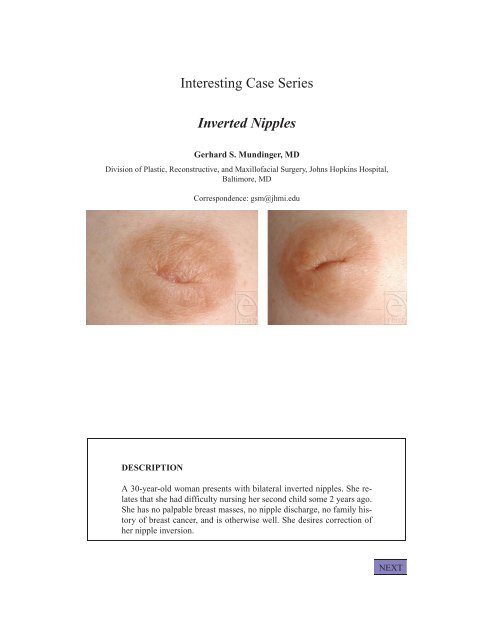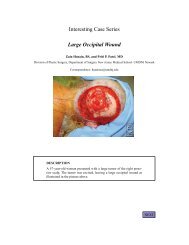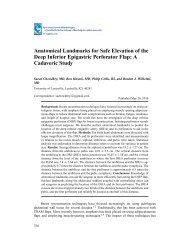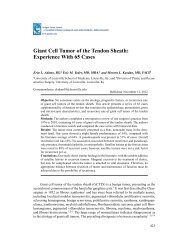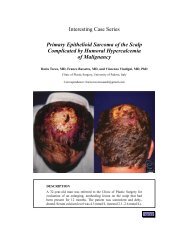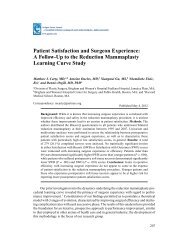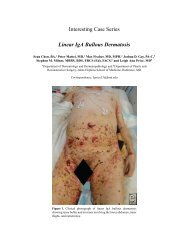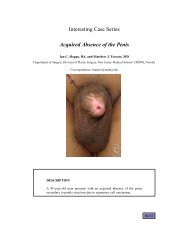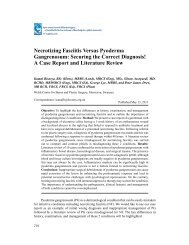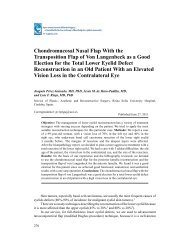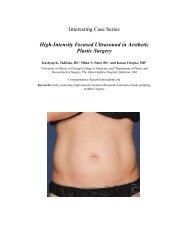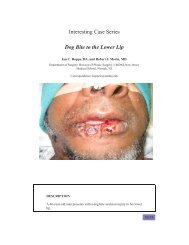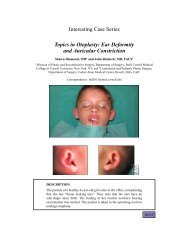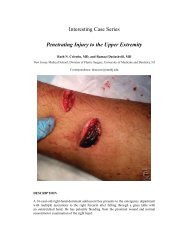Interesting Case Series Inverted Nipples - ePlasty
Interesting Case Series Inverted Nipples - ePlasty
Interesting Case Series Inverted Nipples - ePlasty
You also want an ePaper? Increase the reach of your titles
YUMPU automatically turns print PDFs into web optimized ePapers that Google loves.
<strong>Interesting</strong> <strong>Case</strong> <strong>Series</strong><br />
<strong>Inverted</strong> <strong>Nipples</strong><br />
Gerhard S. Mundinger, MD<br />
Division of Plastic, Reconstructive, and Maxillofacial Surgery, Johns Hopkins Hospital,<br />
Baltimore, MD<br />
Correspondence: gsm@jhmi.edu<br />
DESCRIPTION<br />
A 30-year-old woman presents with bilateral inverted nipples. She relates<br />
that she had difficulty nursing her second child some 2 years ago.<br />
She has no palpable breast masses, no nipple discharge, no family history<br />
of breast cancer, and is otherwise well. She desires correction of<br />
her nipple inversion.<br />
NEXT
QUESTIONS<br />
1. What is the incidence of inverted nipples?<br />
2. How are inverted nipples classified?<br />
3. What surgical options exist for correction of inverted nipples and what are<br />
the main complications?<br />
BACK<br />
NEXT
DISCUSSION<br />
The incidence of inverted nipples has been variably reported as 3.5% to<br />
10% in the female population. <strong>Inverted</strong> nipples can be psychologically<br />
distressing and can interfere with both lactation and breast-feeding.<br />
Most cases are acquired.<br />
The Han and Hong classification system has been widely adopted<br />
because it has direct implications for surgical correction. Their classification<br />
is based on the intensity of nipple retraction and the degree of<br />
connective tissue loss beneath the nipple. Surgical correction, centers<br />
on release of nipple contracture and maintenance of soft-tissue bulk to<br />
maintain nipple projection. Grade I: The nipple is easily pulled out, and<br />
maintains eversion without traction. For correction, the nipple is manually<br />
everted and projection is maintained with a purse-string suture.<br />
Grade II (presented case): The nipple is difficult to evert and tends to<br />
retract once everted. There is moderate fibrosis and lactiferous ducts<br />
are retracted but not fibrosed. Vertical plane dissection is performed to<br />
release the fibrosis while avoiding damage to lactiferous ducts.<br />
Grade III: The nipple is severely inverted and retracted and immediately<br />
retracts if everted. There is marked lactiferous duct fibrosis/retraction<br />
and marked loss of soft-tissue bulk. Retracted and fibrosed<br />
lactiferous ducts are carefully released, whereas nonretracted, functional<br />
ducts are maintained. Dermal fat grafts, laminated cartilage grafts, tendon<br />
grafts, and multiple variants of breast tissue and dermal flaps can<br />
be used to correct loss of soft-tissue bulk. Eversion is maintained with<br />
purse-string sutures, splints, or suction devices. Endoscopic release of<br />
contracture has been reported for Grades II and III.<br />
The main complications of surgical correction are compromise of<br />
nipple vascular supply from areolar dermal bridges by either overaggressive<br />
soft-tissue dissection or excessive suture tension. If functional<br />
lactiferous ducts are inadvertently divided, patients may have difficulty<br />
with lactation. In addition, nipple sensation may be totally or partially<br />
lost postoperatively.<br />
BACK<br />
NEXT
REFERENCES<br />
Han S, Hong YG. The inverted nipple: its grading and surgical correction. Plast Reconstr Surg.<br />
1999;104(2):389–95. discussion 396–7.<br />
Chen SHT, Gedebou T, Chen PHH. The endoscope as an adjunct to correction of nipple inversion deformity.<br />
Plast Reconstr Surg. 2007;119(4):1178–82.<br />
Dewey KG, Nommsen-Rivers LA, Heinig MJ, Cohen RJ. Risk factors for suboptimal infant breastfeeding<br />
behavior, delayed onset of lactation, and excess neonatal weight loss. Pediatrics. 2003;112:607–19.<br />
Sanuki JI, Fukuma E, Uchida Y. Morphologic study of nipple-areola complex in 600 breasts [published<br />
online ahead of print July 15, 2008]. Aesthetic Plast Surg. doi: 10.1007/s00266-008-9194-y<br />
BACK


